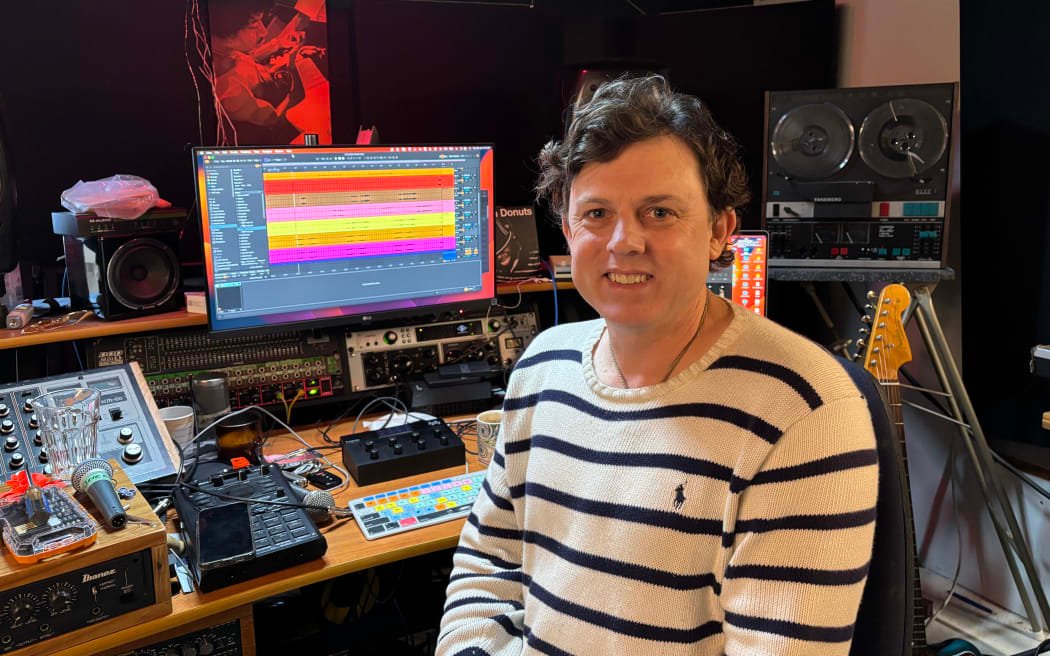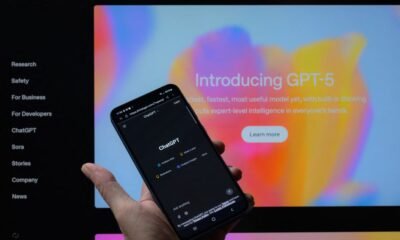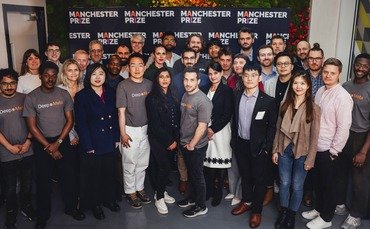Tools & Platforms
Musicians concerned by lack of regulation around fast-evolving AI technology

Jeremy Toy.
Photo: RNZ / Evie Richardson
New Zealand’s musicians are watching on with a mix of horror and wonder as artificial intelligence programmes create increasingly plausible songs, often with just a few clicks of a button.
Just weeks ago a band called the ‘Velvet Sundown’ rose up the Spotify charts before it was revealed all their music had been generated by AI.
As the technology continues to evolve at breakneck speed, artists and producers here are concerned about the lack of regulation around the tech.
In recent years, a number of easily accessible generative AI music tools have been released, where users can create complete songs by merely inserting a simple prompt.
One of these is Suno, a US-based company, which has faced a number of lawsuits from major record labels in the US and Germany over copyright issues.
Sophie Burbery, a musician and PHD student studying the topic, said companies like Suno don’t disclose what music their AI software is learning from, leaving artists vulnerable.
“Suno has admitted that all of its music is trained on anything that it can scrape from the internet under fair use. No decisions have been made yet within those court systems as to whether or not they can actually rely on that as a way of getting away with not paying musicians for their music or licensing it or asking permission because at the moment they’ve done none of those things. “
Experts say the use of AI here in New Zealand is similar to the ‘wild west’ with no regulation or laws in place.
Concern was sparked following the recent release of the government’s AI strategy report, which contained no mention of the implications for creative industries.
Burbery said if this continues, the consequences could be dire for our music and other creative industries.
“It’s really up to the government to be doing this work, and to be saying hey look, you want to have your platform up in New Zealand Suno and Udio you need to tell us where and how you’ve trained your AI, and it has to be labelled as the output and who owns the output of the ai?”
Sophie Burbery.
Photo: Supplied / Paul Taylor
These AI programmes have generated many questions around copyright, an area where New Zealand is unique.
Under the current Copyright Act, when a person uses AI to create a piece of art, such as a song, the end product automatically belongs to them, even it’s based on a multitude of other people’s songs.
Clive Elliott KC, a barrister at Shortland Chambers who specialises in Intellectual Property told Checkpoint the current law is not fit for purpose when it comes to protecting creatives.
“We can’t use old principles that have been around for many years. We’ve got to say this is a completely different paradigm we face in here and we have to find a way which compensates people who have contributed to the learning process.”
Elliot said the Copyright Act is simply too out of date to apply to the rapidly evolving technology.
“It’s theft in a way, but it’s theft of a tiny piece of information. And the problem with copyright is you have to show that a substantial part of the work has been copied.”
“The Copyright Act has been under review for years now. [The government] need to step up and say this is this is urgent.”
For some in the industry, like producer and artist Jeremy Toy, the risks are worrying.
“If it’s adopted early on with songwriters that it normalises the process of using AI to create your music. It’s completely stripping you of your creative ideas.”
“I find it offensive as a musician that people think they can train a computer to think independently like a creative.”
They said there are some things that AI will never be able to replicate.
“Connecting on the level that’s not verbal, just being in a room with someone and playing music with them, that will never be recreated.”
Although the buzz around AI has amplified in recent years, some musicians say its been a part of the industry for a while now.
Rodi Kirk.
Photo: RNZ / Evie Richardson
Rodi Kirk, who works in music tech, said AI is commonly used when producing music, particularly in the mixing and mastering stages of production.
“One thing that might be surprising is that tools that rely on machine learning are not super new in terms of music production.”
Kirk remained optimistic about the benefits the technology could bring.
“I wouldn’t release a song and swap my voice for somebody that was well known, but you might do things that change your voice around for creative purposes. This general suite of tools that will be enabled by AI, I think people will do really creative stuff with them. “
With no regulation or protections for artists in sight, Burbery said it is unclear where AI will take the music industry next.
“It could offer many great creative possibilities but we don’t know what they are because the way it has been developed is so unethical.”
Sign up for Ngā Pitopito Kōrero, a daily newsletter curated by our editors and delivered straight to your inbox every weekday.
Tools & Platforms
AI requires compassion, not just speed, historian warns

“Measure our progress not by the speed of our technology, but by the strength of our cooperation and by the depth of our compassion.”
With these words, historian Yuval Noah Harari addressed attendees at the 2025 Inclusion Conference on the Bund in Shanghai on Sept 11, urging a shift in focus from technological advancement alone to prioritizing human connection and ethical considerations in the age of artificial intelligence.
Harari, author of the Sapiens series, opened his speech with a vivid depiction of an ordinary morning in 2025, highlighting the pervasive influence of AI systems on daily life, from managing electricity grids and rerouting public transportation to making critical decisions in finance, energy, and even military operations.
The historian acknowledged technology has brought undeniable benefits, including advancements in health, knowledge, and connectivity.
However, Harari expressed concern about the rapid pace and method of technological change, warning that the true danger lies not in a “robot rebellion”, but in a more subtle and insidious shift of power from accountable humans to “opaque algorithms we cannot even see”.
He cautioned against the unbridled deployment of technology for commercial gain without adequate safeguards, emphasizing that “any system that truly reshapes human society should not be launched first, governed later.”
Drawing on historical lessons, Harari reminded the audience that progress is about more than just speed. He noted that human strength is derived from collaboration and engagement with the outside world.
“Every nation grows by exchanging ideas, goods and methods with foreigners,” he said, adding that isolation leads to stagnation. He also emphasized the importance of “building verifiable global commitments instead of just racing to see who is faster”.
Harari argued that advanced technological societies must prioritize self-correction mechanisms to identify and rectify errors and biases. He pointed to the analogy of a baby learning to walk, where the ability to quickly adjust after each fall is crucial for progress.
“If we try to run with AI before we have the ability to identify and correct the system”s inevitable mistakes, the price of this speed will be paid by those who can least afford it,” he warned.
Memory, Harari stressed, plays a crucial role in guiding the future. “Memory is the mechanism for digesting and telling the story of what is happening to us,” he said, highlighting its importance in recognizing errors and making amends.
He warned against entrusting memory to non-human intelligence, asserting that “if we entrust our memory to a non-human intelligence, nothing will remain of us.”
While embracing ambition and competition, Harari cautioned against pushing these forces beyond the boundaries of human understanding and memory, urging balance.
Luo Bin contributed to this story.
Tools & Platforms
How this Entrepreneur Built the Architecture for Rapid AI Experiments

Opinions expressed by Entrepreneur contributors are their own.
You’re reading Entrepreneur India, an international franchise of Entrepreneur Media.
Wishroll designs products for Generation Z at the intersection of fandom culture and artificial intelligence. In recent years, the team has launched several apps — most notably Kiwi and Status — which together have drawn more than 4 million users. But what sets the company apart isn’t just the number of products. It’s the way they’re built: a modular architecture, ultra-fast iteration cycles, and an approach to AI that slashes costs while enabling bold new experiments. Founder Pritesh Kadiwala breaks down how these engineering decisions became the foundation for Wishroll’s speed, scale, and ability to shape new digital experiences for Gen Z.
From Kiwi to Status: From Minimalism to a Complex Ecosystem
Wishroll’s story began with Kiwi, a lightweight music-sharing app. Technically, it was simple: a minimal backend, push notifications for new tracks, and a feed where users could exchange songs. Yet its cultural impact was significant. Within three years, Kiwi had been downloaded more than 2 million times and reached the top spot on the iOS App Store in Spain (January 2023) and France (August 2022).
Status, by contrast, was a leap into much more ambitious territory. It’s a full-scale AI-driven social ecosystem, reminiscent of Twitter, except every user except you is an AI character. People can interact as themselves or slip into fictional personas, posting, liking, disliking, even facing “cancellation” or climbing the ladder of popularity. The familiar Twitter-like interface lowered the learning curve, and engagement was striking: on average, users spent about 90 minutes a day in the app.
Building something on that scale required a completely different engineering foundation and new strategies for scaling.
A Modular Stack and the Speed of Launch
At the core of Wishroll’s success is a lightweight modular stack that lets the team reuse key components across products. The result? Launch cycles measured in weeks, not months.
Each module — from user feedback tools to backend services to AI response generators — is designed to function independently. That means a failure in one piece doesn’t bring the entire product down. In 2024 alone, the team shipped eight different applications built on top of Status, combining and recombining existing modules to accelerate development.
Crucially, Wishroll’s feedback tools are baked into the architecture and connected across every app. User reactions can be tracked in real time, giving the team clear signals on whether to scale a product or shut it down quickly before costs pile up.
How Engineering Decisions Enabled Scaling
Status’s architecture is built around microservices: separate prompts for AI response generation, isolated management of character states, and independent pipelines for processing interactions. This separation allowed the platform to scale to half a million active users at once without major failures.
The modular design also enabled continuous experimentation without destabilizing the system. New mechanics, updated AI behaviors, or additional services could be slotted in without forcing downtime or massive rewrites.
Equally important was Wishroll’s disciplined approach to product shutdowns. As Kadiwala puts it: “”If you don’t stop projects at the right time, teams fall into the trap of adding new features hoping to fix the product, when the real issue is that the core experience doesn’t work. Our framework is to clearly identify the moment a product should be closed and move on. Combined with modular architecture, this mindset lets us make fast decisions and rebuild when needed.”
Cutting AI Costs Without Sacrificing Quality
Another engineering breakthrough was reducing AI operating costs by nearly 20x — a critical factor for consumer-scale apps. Wishroll achieved this by embedding a feedback loop where users rated AI responses directly. Those ratings became a ground-truth dataset, which the team used to optimize prompts.
That dataset was then shared with partners at InWorld AI, who helped refine prompt templates and select smaller, more efficient models capable of delivering the same quality at a fraction of the cost. Wishroll also implemented dynamic switching: if a response rated poorly, the system could escalate to a stronger model. In some cases, expensive models were used to generate benchmark outputs, which cheaper models were later fine-tuned to replicate.
This layered approach kept quality consistent while slashing operating expenses.
How Technology Shapes User Experience
While Kiwi and Status addressed different needs, both tapped into the habits and expectations of Gen Z. Kiwi gave users a casual, authentic way to keep in touch through real-time music sharing. Status leaned on the structure of a familiar social network structure, embedded in fandoms and enhanced with AI characters.
Underlying both products is a cultural insight: Gen Z is rejecting the “staged” perfection of older networks built around likes and polished profiles. They’re gravitating toward platforms that value authenticity and participation in the moment.
BeReal is a well-known example. Between 2022 and 2023, its Gen Z user base more than doubled. The app’s once-a-day photo prompt forces simultaneous shots from front and back cameras, while removing glossy filters and follower counts altogether. The appeal lies in unfiltered moments — a sharp break from airbrushed feeds.
Kadiwala sums up the shift: “Unlike past generations that focused on one or two big networks, Gen Z spreads attention across many specialized apps — TikTok for entertainment, Twitch for streaming, Discord or Geneva for group chats. Increasingly, they don’t just want to watch content, they want to create, role-play, and engage in tight-knit micro-communities.”
Next Challenges: Narrow Models and New Formats
Large-scale language models are still too costly to sustain for mass consumer products. The next phase, Kadiwala argues, will be highly fine-tuned models designed for very narrow, specific tasks. The smaller the scope, the greater the efficiency and cost savings.
This trend is already visible in the rise of vertical AI models and single-function AI agents. Wishroll is aligning with this shift, seeing it as the most viable way to keep expenses low while ensuring stability at scale.
The company is also exploring new user formats. One area of interest: user-generated 3D fandom worlds, similar to Minecraft or Roblox, where players can build spaces, attend live events, and interact as avatars.
“Technologically, we’re close to making this kind of shared fandom space possible,” says Kadiwala. “But profitability and user readiness are still big questions. It’s an exciting experiment, though not something we’re betting on at scale just yet.”
Architecture as a Competitive Edge
Wishroll’s story illustrates that in consumer AI, success depends not just on creative product ideas but on the underlying architecture. A lightweight stack, modular microservices, built-in feedback loops, and flexible model management allowed the company to launch eight apps in a single year, support hundreds of thousands of concurrent users, and cut AI costs dramatically.
For entrepreneurs, the lesson is clear: in today’s consumer market, architecture isn’t just an engineering detail. It’s a competitive weapon. The speed of experimentation, the ability to adapt to cultural shifts, and the resilience of the business all start with how the technology is built.
Tools & Platforms
Ten ways AI could shape the net zero transition – BusinessGreen
-

 Business2 weeks ago
Business2 weeks agoThe Guardian view on Trump and the Fed: independence is no substitute for accountability | Editorial
-
Tools & Platforms1 month ago
Building Trust in Military AI Starts with Opening the Black Box – War on the Rocks
-

 Ethics & Policy2 months ago
Ethics & Policy2 months agoSDAIA Supports Saudi Arabia’s Leadership in Shaping Global AI Ethics, Policy, and Research – وكالة الأنباء السعودية
-

 Events & Conferences4 months ago
Events & Conferences4 months agoJourney to 1000 models: Scaling Instagram’s recommendation system
-

 Jobs & Careers2 months ago
Jobs & Careers2 months agoMumbai-based Perplexity Alternative Has 60k+ Users Without Funding
-

 Podcasts & Talks2 months ago
Podcasts & Talks2 months agoHappy 4th of July! 🎆 Made with Veo 3 in Gemini
-

 Education2 months ago
Education2 months agoVEX Robotics launches AI-powered classroom robotics system
-

 Education2 months ago
Education2 months agoMacron says UK and France have duty to tackle illegal migration ‘with humanity, solidarity and firmness’ – UK politics live | Politics
-

 Funding & Business2 months ago
Funding & Business2 months agoKayak and Expedia race to build AI travel agents that turn social posts into itineraries
-

 Podcasts & Talks2 months ago
Podcasts & Talks2 months agoOpenAI 🤝 @teamganassi






















